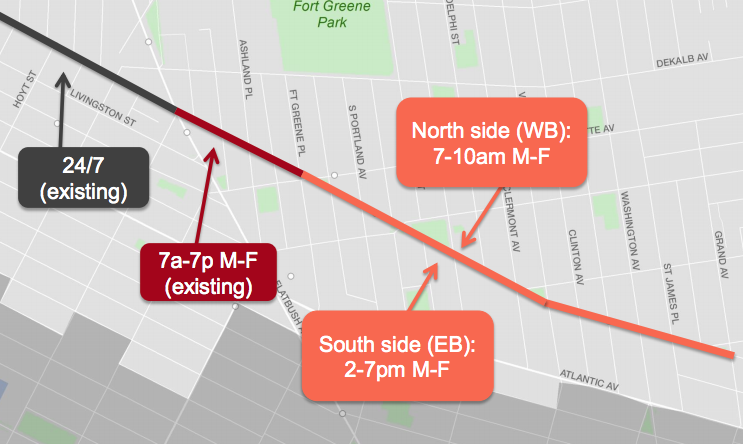Council Member Laurie Cumbo Opposes Fulton Street Bus Lane
Cumbo is fighting a transit improvement that will benefit tens of thousands of people in an area where about two-thirds of households don't own cars.

Council Member Laurie Cumbo wants DOT to scale back bus lanes planned for Fulton Street in Fort Greene.
In posts yesterday on Facebook and Instagram, Cumbo approvingly shared a photo of a small group of demonstrators outside the Key Food at 991 Fulton Street, whose owners are against the bus lanes. “Buses Only = Bad Business” read a typical sign.

About half the demonstrators — Lucy Koteen, Schellie Hagan, Joe Gonzalez, and Community Board 2 member Ernest Augustus — have fought every attempt to reallocate car space in the neighborhood for years. By siding with them, Cumbo is fighting a transit improvement that will benefit tens of thousands of people in an area where about two-thirds of households don’t own cars.
Each day, bus riders make almost 20,000 trips on the B25 and B26, important links to downtown Brooklyn from Bed Stuy and points east. East of Flatbush Avenue they move at a snail’s pace during the busiest times of day. At peak hours, when ridership is highest, the buses travel between 7 and 8 mph, according to DOT.
To speed up bus trips, the city plans to replace curbside parking on Fulton Street between Grand Avenue and Lafayette Avenue with rush hour bus lanes, which would be in effect on weekdays from 7 a.m. to 10 a.m. westbound and from 2 p.m. to 7 p.m. eastbound [PDF]. It would basically be a rush-hour extension of existing bus lanes between Lafayette and Flatbush, and the Fulton Street transit mall.
In her social media post, Cumbo said car parking is more important: “The challenge with the Department of Transportation’s proposal to implement a ‘buses only’ lane along Fulton Street between Grand and Lafayette avenues is the removal of much-needed parking for residents and small businesses.”

Cumbo took particular issue with the 2-7 p.m. eastbound bus lane, which will speed B25/B26 trips at the time when ridership is highest and bus speeds are lowest. Reducing that five-hour window would be another compromise at bus riders’ expense: The city already scaled back bus lane hours at the behest of CB 2 in response to feedback from Fulton Street businesses.
In February, DOT reps told members of Brooklyn Community Board 2 that much of the bus-slowing congestion is due to double-parking and deliveries, according to Brooklyn Paper. The agency surveyed businesses on the street and found their delivery hours were concentrated in, though not limited to, the middle of the day.
With private parking allowed to take up the curb, deliveries can wreak havoc. The most recent images of the Key Food on Google Street View show parked cars and delivery trucks blocking the entire eastbound side of the street:

Cumbo claimed the plan would negatively affect “small businesses who provide jobs and access to critical resources such as groceries to residents of all ages — particularly our families and seniors.”
But these stores are serving an area where people get around by walking and transit. Most people don’t own cars and they’re not driving a few blocks to pick up groceries. A short walk away, businesses have thrived for decades on the transit-priority Fulton Mall, where car access is much more restricted than what DOT is proposing for these blocks. It’s the buses and the trains that are bringing customers.
You’d never know it from Cumbo’s post, but bus riders are also “families and seniors” who need “access to critical resources” in the neighborhood.


